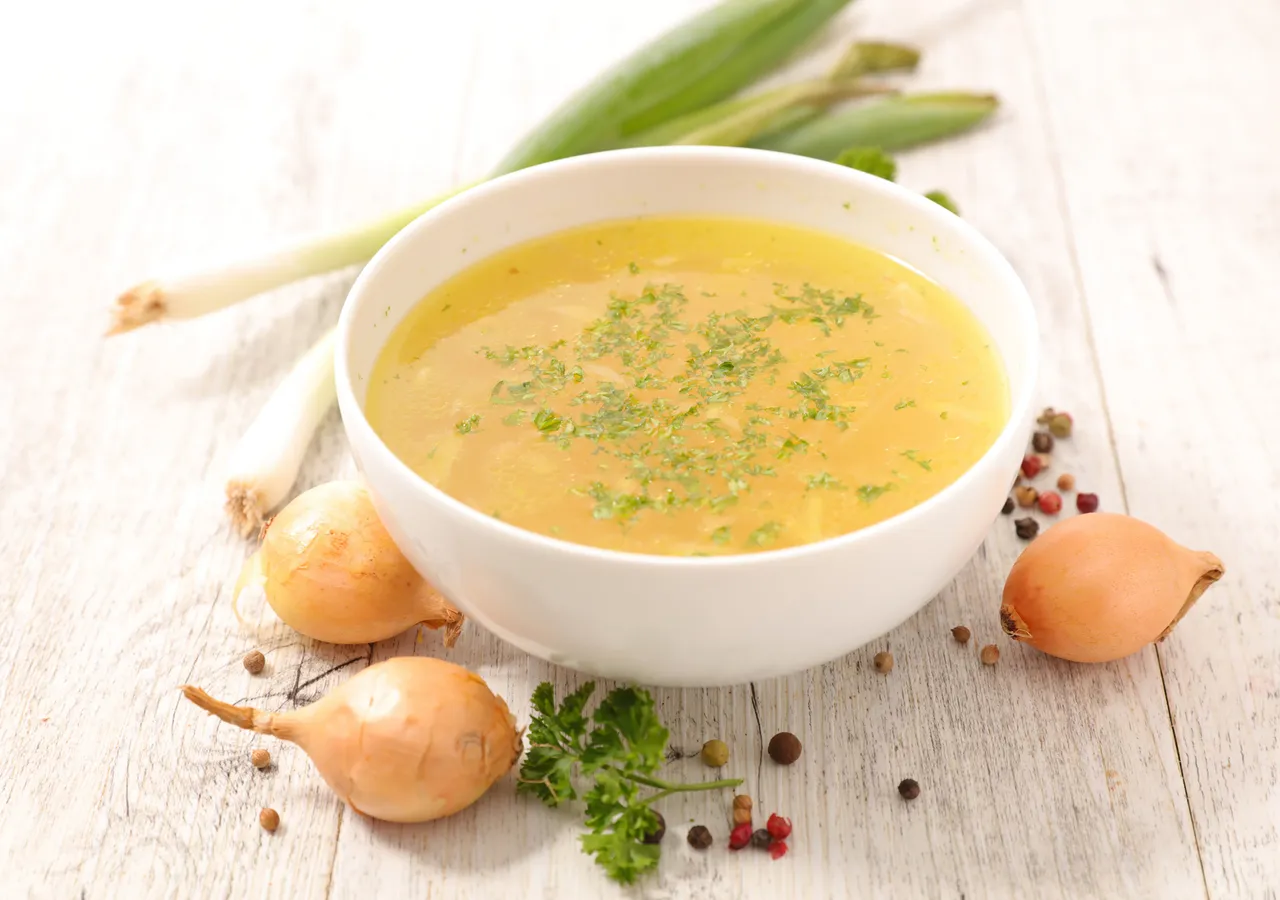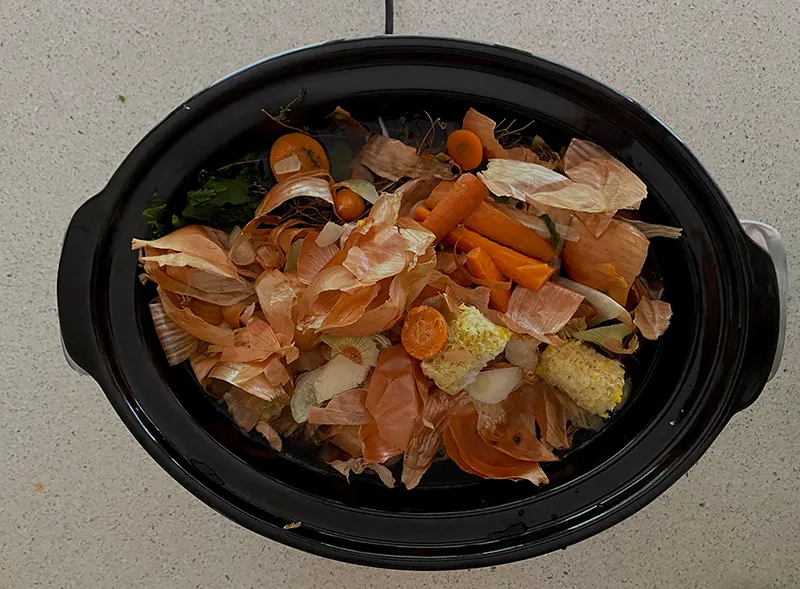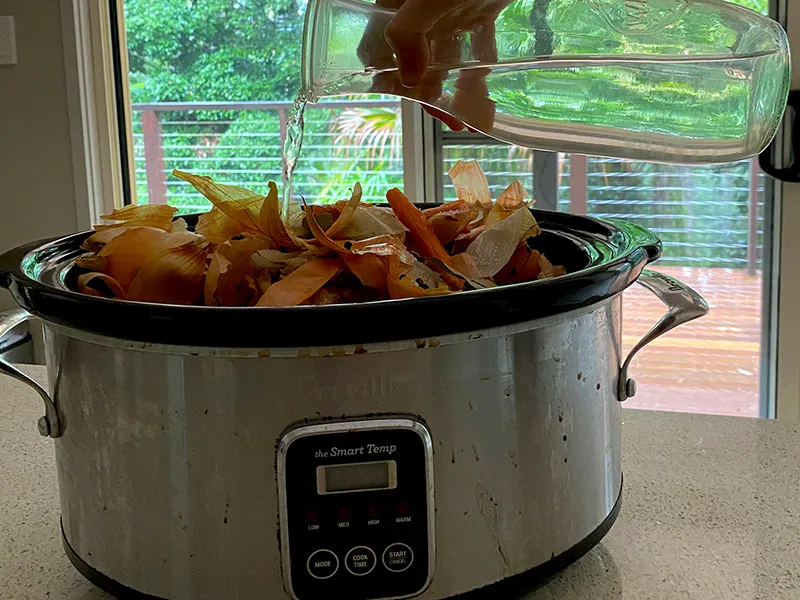Make your own bone broth or vegetable stock

Save food waste and money by using food scraps to make your own broth. Nicole Lutze shares the benefits of broth, what to use and how to cook it.
Heralded from a time when meat consumption was typically low and nothing went to waste, bone broths utilise animal waste products (think: bones, cartilage and feet) to create a frugal yet nourishing dietary addition. Almost every culture has a version, and the health benefits can be so great that chicken broth earned the nickname Jewish Penicillin during the 12th century.
In more recent years, popular paleo and gut-healing diets have thrust this old fashioned remedy into the hipster spotlight. In major cities like New York, a large cup of chicken broth from a fashionable bone broth bar will set you back about AUD$12. A 260g jar of gelatinous concentrated bone broth costs almost $30 at a health-food store back home in Australia. If you’re wondering how peasant food became so darn expensive, I have good news. Making bone broth at home is as simple as boiling water and almost as cheap. And for the vegetarians or vegans amongst us, fear not — vegetable stock is just as easy but a little faster to make.
WHY MAKE YOUR OWN BROTH?
While proper bone broth is expensive to purchase, on the flip side is powdered stock. Powdered stock cubes are cheap and convenient but contain far less nutrition than a homemade stock or bone broth. So, if you want to make something that’s cheap *and* healthy, homemade is the way to go.
It’s great for reducing waste because broth is literally made from offcuts and waste.
Save up any limp vegetables, offcuts, peelings or herbs, add them to a zip lock bag and store them in the freezer. When you have enough, use them in your bone or vegetable broth, giving them an extra life before their finale in the compost. Always try to compost your scraps instead of sending them to landfill where food decomposes anaerobically (without oxygen), producing methane, a greenhouse gas far more potent than carbon dioxide.
HEALTH BENEFITS
One of the main reasons bone broths have resurged in popularity is because of the high gelatin content. Gelatin is an excellent gut healer because it improves gastric acid secretion and restores health of the mucosal gut wall. This wall helps nutrients enter and keeps toxins out, so it’s an essential part of our digestive system. Plus, approximately 70 per cent of our immune system is housed *inside* our gut— so it pays to keep our gut healthy and happy.
Broth also aids digestion, offers minerals like calcium, magnesium and potassium in a readily absorbable form, and acts as a protein sparer. A protein sparer is something that allows your body to readily absorb and store the proteins you eat it with. This means, if you use consume bone broth with meat, you can eat less meat, get the same health benefits *and* your body will prioritise storing that protein for vital metabolic functions instead of burning it for energy. You’re basically being strategic about your meat consumption, which is handy during a climate crisis when people should be considering the impact of their diets. Clever, huh?
HOW DO I MAKE BROTH?
There are no steadfast rules for making broth, so no matter what you do, you really can’t go wrong. Ultimately, the goal is to create a bone broth that’s semi-solid like jelly. These gelatinous broths contain the most gelatin and are therefore the most healing. That said, even a very runny liquid stock will contain valuable nutrients and plenty of flavour.
Here’s a very basic recipe for broth, but don’t worry, you can substitute ingredients. As long as you have bones, vegetable scraps, a dash of apple cider vinegar to draw out minerals from the bones, and enough water to cover it — you’re doing fine.
- Approximately 2kg of bones (this can be a mix of animals or just one type, and the bones can be roasted or raw)
- 1/4-1/2 cup of apple cider vinegar
- Leftover vegetables and herbs (several handfuls worth)
- 3-4 litres of water
- A few bay leaves (optional)
- You may also like to add a few cloves of garlic and some peppercorns. However, if you want to keep the broth simple and therefore more versatile, omit these flavours.




Bone broth should be simmered (not boiled) from 4-24 hours, on a stovetop or in a slow-cooker. See below for a basic guide to cooking times:
- Fish stock: 4-12 hours
- Beef and lamb bones: 12-48 hours
- Poultry: 6-24 hours
- Vegetable: 2-6 hours (vegetable stock can be cooked at a higher heat than bone broths because we aren’t trying to extract nutrients from bones)
Once cooked, strain your broth, compost the vegetables and bin the bones (or, if you’re feeling up to it, do a quick Google search on how to compost bones. It’s a tad more tricky than regular composting, but a great skill to have).
Broth will keep for about a week in the fridge, so if you won’t use your entire batch straight away, it’s best kept frozen. I store mine in old glass jars, but you can also freeze some in ice cube trays.
WHAT CAN I PUT IN MY BROTH?
While it might sound revolting, chicken feet, hooves, knuckles, cartilage, tendons and marrow are all extremely nutritious additions to bone broth that will create a more gelatinous finished product. You’ll also find that healthy, grass-fed animals will produce a more gelatinous broth. Prawn shells and fish heads are great for seafood stocks, and when it comes to vegetables, the options are almost endless. Celery stalks and leaves, carrot peelings, onion and pumpkin skins, herbs, and corn cobs are the most common additions to my stockpot. Avoid brassicas like broccoli, cabbage, kale and brussel sprouts, as they create a strong flavour, and never use spoiled vegetables (though wilted is fine).
HOW DO I USE MY BROTH?
The most obvious way to use homemade broth is in soup, stew, casserole or risotto. You can also use it instead of water when cooking rice, couscous, quinoa or other grains.
A cup of warm broth can also be both healing and tasty. To mix things up, add some extra flavour to your cup by incorporating ingredients like ginger, garlic, turmeric, soy sauce, lemon, chilli, herbs, salt and pepper. Alternatively, if you’ve kept your broth simple and it doesn’t contain garlic or pepper, you can create a sweet cuppa by adding cacao, honey, cinnamon and/or ginger.
If you’re a regular baker, try substituting broth for water in your bread or pizza bases.
Original Article here: www.liveforless.com.au/diy-bone-broth-vegetable-stock







